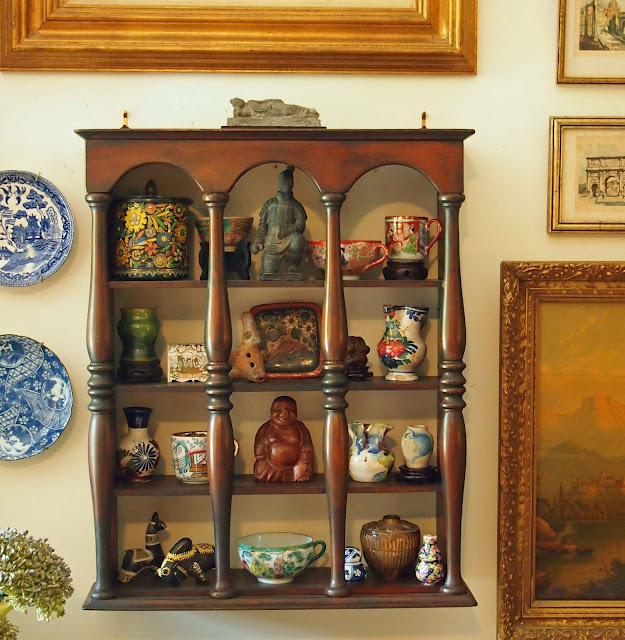Chinoiserie Faux Ivory
Much more in keeping with my personal design style, this faux ivory elephant handled urn is a keeper. I saw this well before my birthday but the price point ($$$) was way too high for any serious consideration. Despite my upcoming birthday, I talked myself out of any thoughts of it. Or so I thought...This week I went back and it was on clearance as was everything else by the seller. (To my credit I passed up affordable Imari-ware and blue & white porcelain.) I held it for a while, a long while, walking about the store, trying to finding something more reasonable that I might want more. My research into the piece poured from my memory. I tried to talk myself out of it, but it was a very good price.
I brought it home and put it in the closet. No place for it. It broke all the rules of buying including the first two. Where will I put it? How will I use it? Yes, beauty for beauty's sake is acceptable for use, but it's large, and it's heavy, and I have no place to put it. The natural spot for it has glass shelves which already hold books, pottery, and more. Once again: Where? How? Should I change a room to accommodate it?
Here it is in all its glory.
The scene wraps around the vase. The elephant heads are handles breaking up the image. To either side of the ears (below) a roof is divided. The other ears split apart a landscape. The background of the scene is beautiful. The mountains are ancient and worn away. A valley or perhaps a river flows. The are subtle striations to demarcate the area. Another homestead is seen across the river/valley. It is comprised of multiple structures joined as one. It gives a glimpse of what the home of the foreground may be like. This distant complex wraps around onto the other side continuing beyond the elephant handle. We see an outer fence with an open gate on the second side. Deliberate landscaping such as a shaped tree, shrubs, stones, and elevated terrace are present. Then, beyond this distant home, a much smaller, more distant homestead is seen. Unlike the closer neighboring home, it is not fenced or gated. However, on a nearby hillside a number of straight lines appear over several crests. Perhaps it is some kind of crop?The members of the family appear posed on opposite sides of the house, each pose different but similar enough to connote familial ties. The same grouping of two women and one child appear. Due to the similarities in attire and hair, I believe the people are the same. The child is in pants and the hair gathered at the sides in small knots indicating it is a boy. Perhaps the opposite sides with different poses indicates a different time of day. There is no sun, no shadows to support this idea though but the behavior between the adults and the boy does seem to be progressing between the panels as he moves between the two women. The top of the vase is curved in an undulating pattern which varies slightly in thickness with some lines seeming to break it into sections. I think the intention is to reflect the cloud line as seen from below. Because the pattern repeats between the elephant heads, I think this further supports the idea that this was created from a mold. There is a one inch section which has a chipped away section above one of the ears.
A tree near the house is seen emerging from both sides. Its leaves and branches and twisting trunk are distinct. Other planned landscaping is seen. Fencing, placed stones, and pruned shrubs separate the outdoor gathering area from the surrounding landscape. Beneath their feet a square pattern appears to indicate that tiles or stones were placed. The house is raised upon a foundation made in sections of cut stones and panels of either ornamentation or divided to allow air flow. A porch surrounds the house. At the porch floor it has a fence like the one on the ground. The pattern is the same. In addition, that pattern is repeated at the top of the porch. Windows, such as movable shutters, appear on the walls. The crosshatching indicates they are woven. The detail is so good that the wood holding the windows into the framework of the walls is seen and sectioned panels on the walls are present. Even the porch posts have decorative footers.
It is likely a resin, not the ivory hinted at by the Asian elephants used as handles. The small ears and decoration atop the head reinforce their identity as Asian. Despite very few Asian elephants within modern China's borders, their past history is well documented. It is most likely a molded piece from a reusable form. The base at the bottom has a distinct line at the footer. (Bottom picture. Dentation at center.) The base is probably poured as part of the vase and unable to be separated. The details are all attached with the exception of the elephant trunks which serve as handles. Hand carving may sometimes have areas where the branches or leaves would be separated from the surface. None of that is present lending to the idea that it is a poured molded piece.





